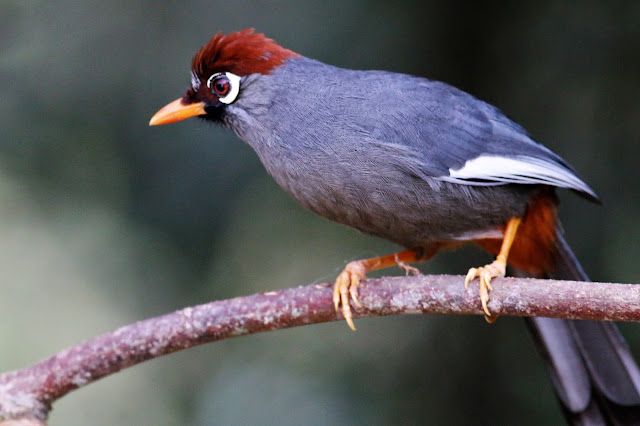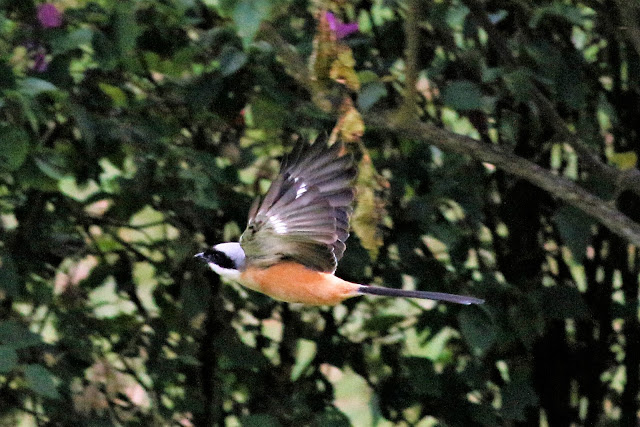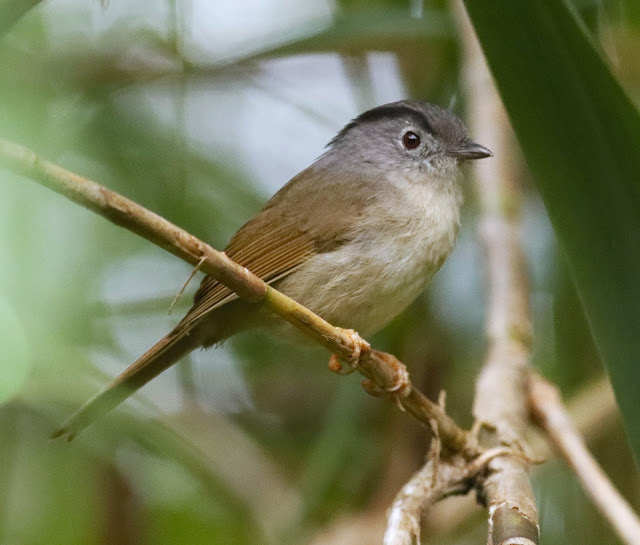 |
| Black-crowned Night Heron |
This heron is a stand-and-wait predator which forages communally. It has a rather long scientific name i.e Ardea nycticorax nycticorax. They will appear during dawn or dusk near areas with large body of water for example lakes, river mouths and ponds. Large colonies can be seen near Putrajaya Wetlands, Rawang, Sabak Bernam, Malim Nawar and Penang mainland.
 |
| Orange-bellied Flowerpecker |
A common but very tiny flowerpecker (only 8 cm) which you would likely find in most jungle trails here.
 |
| Purple Heron |
Apparently in Japan, this heron is called Murasaki-sagi and it also has a very long scientific name i.e Ardea purpurea manilensis. Males are reportedly larger and darker than females.
There are not many field guides describing the blue lores appearing on Black-crowned Night Herons when they are in breeding colors. Here are two breeding males squabbling over a potential nest site.
 |
| Grey-throated Babbler |
Although quite common here but this babbler is more often heard than seen. They are more common at sub-montane or mountain levels as i have observed.
 |
| Grey-Headed Babbler |
Although not globally threatened this is an uncommon babbler which mainly dwelled in the under layers of thick jungles. Its a monotypic babbler which can be found only in this region.
 |
| Black-capped Babbler |
Also a sulker but it can however be seen more often than the above babbler.
 |
| Grey-breasted Spiderhunter |
Locally named as "Kelicap Pisang" because of its penchant for wild banana flowers as seen above.
 |
| Silver-eared Mesia |
So happy to have such a colorful bird here. An iconic bird of sub-montane and mountain range.
They look just as elegant whether from the front or back.
 |
| Chestnut-capped Laughingthrush |
Another common and iconic bird of the sub-montane and mountain regions over here.
 |
| Black-throated Sunbird |
Initially i thought i was looking at a new bird but it was just a male Black-throated sunbird in heavy molt.
 |
| Sooty-headed Bulbul |
From the color of its yellow vent this bulbul is most likely from the Ssp germani. In Northern Sumatera it can be found throughout the higher elevation.
I saw this accipiter in Northern Sumatera and identify it as a "Besra" instead of a Japanese Sparrowhawk based on its dark greyish upperside, wing tips does not accede the half way line of its tail and broad tail bands. Some birders are a bit sceptical of the id but i will just leave the discourse open for further comments.
Note: correction ! A raptor expert from Thailand as well as other local experts have confirmed that the above accipiter was a juvenile Japanese Sparrowhawk. Case closed !
Note: correction ! A raptor expert from Thailand as well as other local experts have confirmed that the above accipiter was a juvenile Japanese Sparrowhawk. Case closed !
 |
| Oriental-Magpie Robin |
Nowadays you will see this robin more often in the cities and town areas. They have adapted well with the humans. The above male OMR was however spotted in the jungles of Pahang and its calls are slightly different than its city dwelling cousins.
The above two photos of a Verditer Flycatcher trying to catch a dragonfly was taken at 8.00am. It was still dark in the jungle but breakfast must be taken whenever opportunity arises.
 |
| Dark-sided Flycatcher |
A migratory flycatcher in this region. Location: Semangkuk Waterfall, Pahang.
 |
| Long-tailed shrike |
Some books have described them as butcher birds - probably came from the way they annihilate their prey. I noticed that they too do rattle like a brown shrike but when alarm they would produce a one note call which sounded like "chack" as heard.
The white patch on its outer primaries most likely shows that it is from the nominate Ssp schach.
An Asean Glossy Starling showing its glossy emerald green colors.
 |
| Little Cormorant |
Little Cormorant has been making a strong presence here. A large number of them can be seen in Malim Nawar ponds and a few in Penang and Perlis. The above was seen in Merbok, Kedah. They are often associated with catching fish underwater but when they are airborne they can actually fly really high as observed.
 |
| Dollar Bird |
Looks 'same same' but not really identical. Most of them are migratory birds and female is reportedly larger than male. The one above looks darker though.
 |
| Large Woodshrike |
The tiny white speckles as seen above are actually the remnants of a butterfly.
Waders are an important part of the inter-tidal ecosystem. Most of them are migratory as over-wintering birds will eventually return to their breeding grounds sooner or later.
The above sandpiper should be a 1st winter bird as evidently shown by the streaks on its chest.
(Winter plumage: overall greyish, lacks black carpal bar and streaks on forehead)
A new decade and a new hope !
THANK YOU.
 |
| Lesser-Crested Tern |
Said to breed in the Mediterranean and is a rare winter visitor here. It has a more orangey colored and slender bill than a Great Crested Tern.
 |
| Whiskered Tern |
(Winter plumage: overall greyish, lacks black carpal bar and streaks on forehead)
A new decade and a new hope !
THANK YOU.































